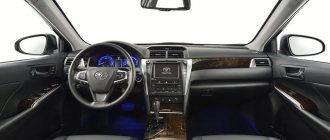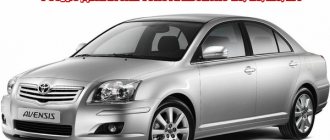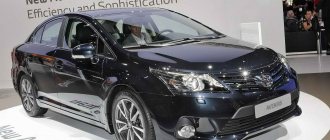Avensis and Camry are products of the same concern, but the philosophy of the cars is completely different. Avensis is a product of the European school, Camry is an American one. Hence all the pros and cons of cars.
Both cars have a difficult life path - from unquestioning worship in their homeland and the rapid conquest of other continents, to the loss of sales markets. The Camry business class sedan is especially popular in the USA and Asia, where factories were built specifically for it in Thailand, China, the Philippines, Malaysia and Taiwan. An equally talented representative of the “D” class, Avensis, has its fans in Europe and is produced only in Foggy Albion.
Avensis T270 and Camry XV50
Unfortunately, in Russia the choice is limited: only Camry can be purchased from a car dealership; deliveries of Avensis stopped in 2012. But a large number of offers on the secondary market makes you wonder: Avensis or Camry, which is better.
"Toyota Avensis"
"Toyota-Avensis"
"Toyota-Avensis"
Just a year ago, such a dilemma was impossible in principle: it is clear that there were few people willing to buy a smaller car of the same brand for a lot of money. Therefore, it is not surprising that in Russia the Avensis sold many times worse than the Camry. However, this year the market situation has changed, and now the choice between two Toyotas is no longer so speculative.
What Nissan Teana and Toyota Camry are hiding on the secondary market
Let's see what the secondary market is ready to offer to the buyer of these models. Let's check cars for sale through the Autocode service by their license plate number.
It's a nice looking car, but there's no explanation in the ad. Having carefully analyzed the report, we identify a number of shortcomings.
The car had an accident, which, judging by the insurance calculations, was not serious.
But special attention should be paid to the collateral. This means that the mortgagee can take the car at any time, because it is he who owns the car until the debt is repaid.
If you look at the advertisements for Camry, there are no less situations when the car has several problems. We were attracted by this ad:
Similar to the Teana, this car, judging by the ad, has no obvious signs of an accident. And it was.
One accident in 2015. But, most likely, not serious - “Collision into a standing vehicle.” This could also happen if parking near the house was unsuccessful.
But inaccuracies in mileage already give reason to think before purchasing. In 2021, 241 thousand mileage was recorded on the diagnostic card. And in 2021 – already 125 t.km. Perhaps the mileage is twisted. And if, due to the general condition of the body, the hidden high mileage may not appear, then on the internal systems and assemblies this will appear at the next maintenance.
Toyota Avensis, Elegance+ equipment
For more than a year, Avensis practically did not rise in price. And last winter the car was noticeably refreshed, having undergone a quite successful restyling. Having fluffed his mustache and squinted slightly, the sedan clearly looked prettier. At the same time, as before, the car attracts with its rather rich basic equipment. In “Comfort” for 914,000 rubles. there is almost everything you need, with the exception of light alloy wheels. The situation is completely corrected by the amount of 40,000 thousand, which should be paid extra for the “Prestige” package: such a car will have climate control, a 6.1-inch color display and a number of other pleasant little things in the cabin. Putting another 49 thousand on top, you get a “Prestige” with a CVT.
Equipment
Interestingly, the basic list of equipment for the Toyota Avensis includes seven airbags, which even includes a device that protects the driver’s knees. To become the owner of such luxury, the Camry owner will have to fork out for the most expensive equipment. But in the field of active safety, both cars are equal - both Avensis and Toyota Camry are equipped with multi-channel ABS, complemented by a braking assistance system and an electronic stabilization system. If we talk about comfort, Camry will have no equal in this area, because already in the “base” this mid-size sedan is equipped with automatic climate control, as well as rain and light sensors. If we compare Toyota Avensis and Camry, we can note that only the latter has a full power package in its base, including heated seats and mirrors, while the smaller sedan will require an additional payment even for rear windows.
Already in the average configuration of the Toyota Camry, the driver and front passenger can use a multimedia system with a large touch monitor (8 inches). It can display navigation maps or readings from a rear view camera, which makes it easier to drive a large Toyota sedan in urban environments. For Avensis, a similar system is also available, but you will have to take a closer look at the maximum configuration, which is priced quite expensive. But it has everything that a modern person needs who does not want to lag behind the latest technological advances:
- Bluetooth wireless connection;
- Ability to access the Internet via a mobile device;
- Clients for email, news reading and online browsing;
- Voice control;
- Possibility of calling using Hands Free.
Perhaps, the maximum configuration of the Toyota Avensis will be even more useful for the modern businessman than the Camry, which welcomes the traditional values.
"Toyota Avensis", "Comfort"/"Prestige" equipment
As an alternative to the Avensis, you can consider the Camry with an automatic transmission and a more powerful 2.5-liter engine; the basic Comfort will cost 1,028,000 rubles. Although such a car pleases with the generosity of equipment, to get it with leather and an electric driver’s seat, you will have to pay exactly the same as for the Avensis-Prestige.
About the name, logo, emblem
Over its almost 100-year history, the company's name and symbols have changed several times. There is no consensus on what is depicted on the emblem and what the Toyota logo means.
How is the word “Toyota” translated and what does it mean?
Initially, the corporation was called "Toyoda", which literally translates as "fruitful rice field." The name change from “Toyoda” to “Toyota” was caused by the Japanese belief in the number “8”, which brings good luck (the spelling of the word “Toyota” in katakana consists of 8 dashes). Another reason was the desire to get away from association with agriculture.
The word “Toyota” only means the company itself, since in Japanese it is written in katakana, and not in hieroglyphs. The syllables of the Japanese alphabet convey only the sound and have no translation. Therefore, the word “Toyota” is translated as a proper name – “Toyota”.
The meaning and history of the emblem
The corporation's emblem - three intersecting ovals - appeared in 1979. There are several interpretations of the symbol. Two versions of origin are a tribute to the corporation’s past. According to one of them, the Toyota icon means a thread inserted into the eye of a needle, or a weaving loop.
According to another interpretation, the Toyota symbol means the unity of the manufacturer, partners and clients or the heart of the buyer, modern technology and product quality. A number of people find the encrypted letters “Toyota” in the ovals.
Toyota logos from different years
During its existence it appeared in seven forms:
Since 1989, the corporation's logo has consisted of the Latin name "TOYOTA" and the emblem located above it. The color scheme is white and red. The Toyota logo placed on the product body means that the product has passed strict control and is an exemplary copy.
"Toyota Camry", "Prestige"/"Prestige+"/"Lux" equipment
Ultimately, it’s the driving qualities of the cars that put everything into perspective. "Avensis" 34 l. With. weaker, but loses only a second to the Camry in accelerating to hundreds. In addition, the Avensis is more maneuverable, more stable at high speeds and more exciting in corners. In addition, it is also noticeably more economical, requiring on average 3 liters less fuel for every hundred. And for the Camry to really drive more seriously than the Avensis, it must be purchased with a 3.5-liter 277-horsepower engine for RUB 1,434,000.
Engines and gearboxes
If, without going into detail, we compare the passport characteristics of the Camry and the Avensis 2007, then it seems that in this regard the Camry is ahead of its opponent. But in practice, everything looks different - the accelerator pedal responds to pressure with a delay. The two and a half liter car comes to life only after 2-3 seconds, but this time can play a cruel joke when overtaking and maneuvering. The reason lies in the automatic transmission, which was borrowed from the Camry V6 3.5, so the power of this engine is not enough. The car is pleasant to drive outside the city, when sudden and frequent acceleration is not required.
Engine Avensis T270
Unlike the Camry, where only an automatic is available, the Avensis is equipped with a choice of manual or CVT. A properly tuned variator smoothly transmits torque to the wheels without noticeable drops in power and provides excellent dynamics. A sensitive gas pedal and a two-liter power unit accelerate the Avensis to “hundreds” one and a half seconds faster in comparison with the Camry, and the speedometer needle exceeds the mark of over 200 kilometers per hour.
If we compare the 2008 Avensis and the Camry 40 in terms of efficiency, then here too the Avensis is ahead - the fuel consumption of the smaller sedan is only 9 liters per 100 km, while a representative of the “business class” will need 11 liters to cover the same distance.
"Toyota Camry", "Elegance"/"Elegance+"/"Premium" equipment
Thus, the Camry is of interest primarily to those for whom “size matters” or need a powerful V6. A large Toyota is well suited for the role of a personal vehicle with a driver. However, it is much more interesting to drive an Avensis, especially since for comparable money it is more economical and safer.
Salon
Comparing the interior of cars, it is impossible to understand which is better than Camry or Avensis. Both cars have low seats, which does not have the best effect on comfort. In the Camry, the situation is saved by a wide center console, which gives the driver a feeling of freedom. Avensis chairs have better lateral support. Also in Avensis, the decorative inserts of the dashboard and doors look harmonious, unlike the pseudo-wood of the Camry.
Salon Avensis T270 and Camry XV50
Making a choice based on comparing Avensis or Camry in terms of rear seat roominess is unfair - the smaller Avensis loses. In it, three passengers in the back will not feel as comfortable as in the Camry, which has simply a huge amount of space in the back. And this is not surprising. For example, Avenis and Camry 2003 onwards. have a length of 4630 and 4815 mm, respectively.
Used Toyota Avensis T250: blind headlights and bad rear suspension
When it comes to reliable cars, many people first think of Toyota. The brand positions itself as a manufacturer of reliable and inexpensive cars. The move was right: in the struggle for leadership in global sales, the company even beat Volkswagen, and the brand’s reputation is higher than ever. However, the second generation Avensis has never been among the sales leaders in our market. But he has a lot of fans. Where does this dissonance come from? The question is almost philosophical. It’s better to talk about what you can expect from a used Avensis, and whether it’s worth buying it at all. Today we’ll talk about the body, interior, chassis and electrics, and a little later – about engines and gearboxes.
History of technology
In Russia, there are not so many Toyota models officially presented, and only a small part of them are heard: Camry, LC, Corolla and Hilux. Avensis in Russia was hopelessly inferior to Corolla, RAV4 and Camry. This very “European” model, even in Europe itself, did not have great sales, leaving Yaris, Auris and even RAV4 ahead. Neither the English assembly nor good adaptation to European tastes, both in design and in trim levels, helped (buyers were offered station wagon cars and a couple of diesel engines).
The history of the Avensis model goes back to the very popular and legendary Toyota Carina E. Introduced in 1997, the Toyota Avensis T220 replaced the Carina on the European and American markets. In Japan, cars in this body received the name Caldina, but the next generation of Avensis, which will be the hero of today’s story, was no longer assembled in Japan and was not delivered to the USA. The Avensis T250 was the company's first model in its class to be imported to Japan.
Pictured: Toyota Avensis Sedan '1997–2000
In the European market, for the sake of the model’s success, they even stopped selling Camry, but the car still didn’t work. In our country, sales of new Avensis have also always accounted for a small part of sales of the large Camry. Which is not surprising: the Camry, with its larger size, better equipment and more powerful engines, was even cheaper. But it was Avensis that was massively imported from Europe until 2009. They were greatly helped by the image of reliable and “long-lasting” models with not very large engines. As a result, there were a lot of these cars on the secondary market.
In the photo: Toyota Avensis Sedan & Wagon '2006-08
There are no revolutionary solutions in the design of the car. Toyota, as usual, is as simple and practical as possible.
The engines on the Avensis were gasoline, with a volume of 1.6 to 2.4 liters, and Europeans also had a choice of two diesel engines. The drive was usually front-wheel drive and only very rarely - all-wheel drive. There were three bodies - a sedan, a liftback and a station wagon, but they didn’t bring liftbacks to us, and it’s almost impossible to find them on sale. Regardless of the body type, the front and rear suspensions are MacPherson.
Among the not so positive aspects, we note the emergence of direct injection for European cars. Along with the 1AZ-FE/2AZ-FE engines, the 1AZ-FSE/2AZ-FSE engines appear on the car, and the very controversial 1ZZ-FE also remains in the line.
Pictured: Toyota Avensis '2003–08
The undoubted advantages of the model include European suspension composure, handling and good interior materials. However, there is no clear opinion here either, even among fans of the brand. Moreover, for comparison you can use completely different cars. Some compare it with the Camry XV40, and others with the Mercedes W203 or Opel Vectra C. The results are predictably different.
Well, what about reliability? I'm afraid it's also very ambiguous. However, judge for yourself.
Body
It’s difficult to find a downright rotten Avensis of this generation. Most likely, the very rotten Avensis had accidents and poor recovery in his biography. But, unfortunately, the model is also not a leader in terms of anti-corrosion protection.
Pictured: Toyota Avensis Sedan '2003–06
Pictured: Toyota Avensis Wagon '2006–08
The rather thin paintwork often fails on the roof pillars and at the top of the windshield frame. Numerous chips are blooming, and the metal in this area is clearly not galvanized; rust spreads quickly. You can even find complaints about leaks at the junction of the windshield and the roof.
Sandblasted areas on arches and thresholds do not bloom as quickly when paint is lost, but, nevertheless, even here, pockets of corrosion appear regularly. The rear wing arch has a particularly hard time: this is due to the problematic rolling with the lack of a full-fledged locker on the front part of the arch. As a result, the arch gradually rots from the inside, and it is difficult to stop the process. It’s good that there are usually no marks on the outside, the processes are slow, there is time for correction, but a complete repair involves “joining” the internal and external arches. This means that no one will carry out a full repair until the part rots through. Stripping and preservative may put off the problem indefinitely, especially if the work is done on time, but you expected more from Toyota?
The bottom is generally well protected. Small pockets of corrosion in places of damage and near the rear suspension mounting points do not cause concern for the strength of the body. In the front part, you should carefully monitor the condition of the seam sealant in the engine compartment. Some machines may already have slightly swollen seams near the cups, and in the future this will certainly lead to expensive restoration work.
Pictured: Toyota Avensis Wagon '2003–06
The bottoms of the doors are also not ideal; corrosion is usually already noticeable from inside the folding and under the rubber bands, but it also does not tend to come out yet. You can also look for signs of corrosion in the trunk, especially if the taillights and floor are wet, but don’t expect any serious defects: the problems are purely cosmetic. Unpleasant, but can be eliminated if desired.
Corrosion in this model is clearly not a priority problem, but attention will have to be paid to the body. In the future, it is worth thinking about a good and regular anticorrosive agent.
The front and rear optics of Avenis are not very good. In the headlights of cars before restyling, the reflectors quickly burn out, causing them to noticeably “blind”. There was even a recall campaign, but after a few years the optics go blind again. In addition, the seam between the body and the headlight itself loses its tightness and leaks in the upper part. You will have to change the headlight assembly or repair it with the installation of new lenses. After restyling in 2006, optics turned out to be more reliable, but, as practice shows, they also burn out noticeably faster than on most cars.











